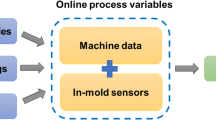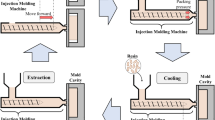Abstract
The automation of cost estimation for manufacturing processes is a challenging task in computer-aided manufacturing. In this paper, we introduce a two-step analogy and mathematical approach to estimate the cost of injection molding. In the analogy step, data of molds are partitioned into homogeneous groups based on mold type and mold design. In the prediction step, regression models based upon geometry, topology, and other inherent shape properties are constructed within each group. The variables in the regression models within each group are extracted automatically from one orthographic two-dimensional (2D) image of the injection-molded part. Mean and variance estimates are calculated on a subset of relevant molds so that the risk of an inaccurate bid can be assessed on a subset of relevant molds.
Similar content being viewed by others
References
El-Mehalawi M (1999) A geometric similarity case-based reasoning system for cost estimation in net-shape manufacturing. Ohio State University
Kwong DCK, Smith GF (1998) A computational system for process design of injection moulding: combining blackboard-based expert system and case-based reasoning approach. Int J Adv Manuf Technol 14(4):239–246
Wong TS (1998) Evaluation of a software package to estimate cost of an injection mold. University of Massachusetts, Lowell
Wang H, Ruan X-Y, Zhou XH (2003) Research on injection mould intelligent cost estimation system and key technologies. Int J Adv Manuf Technol 21(3):215–222
Bergmann R, Althoff K-D, Breen S, Göker M, Manago M, Traphöner R, Wess S (2004) Developing industrial case-based reasoning applications: the INRECA methodology. Springer, Berlin
Shehab E, Abdalla H (2002) An intelligent knowledge-based system for product cost modelling. Int J Adv Manuf Technol 19(1):49–65
Nagahanumaiah K, Mukherjee NP, Ravi B (2005) An integrated framework for die and mold cost estimation using design features and tooling parameters. Int J Adv Manuf Technol 26(9–10):1138–1149
Raviwongse R, Allada V (1997) Artificial neural network based model for computation of injection mould complexity. Int J Adv Manuf Technol 13(8):577–586
Shehab EM, Abdalla HS (2002) A design to cost system for innovative product development. Proc Inst Mech Eng B J Eng Manuf 216(7):999–1019
Chan SF, Law CK, Chan KK (2003) Computerised price quoting system for injection mould manufacture. J Mater Process Technol 139(1–3):212–218
Sapene C (2007) Cost analysis of plastic injection molds. Lulu.com
Latecki L, Lakamper R (2000) Shape similarity measure based on correspondence of visual parts. IEEE Trans Pattern Anal Mach Intell 22(10):1185–1190
Tangelder JWH, Veltkamp RC (2004) A survey of content based 3D shape retrieval methods. In: Shape Modeling Applications, 2004. Proceedings, pp. 145–156
Lou K, Ramani K, Prabhakar S (2004) Content-based three-dimensional engineering shape search. In: 20th International Conference on Data Engineering, 2004. Proceedings, pp. 754–765
Belongie S, Malik J, Puzicha J (2002) Shape matching and object recognition using shape contexts. IEEE Trans Pattern Anal Mach Intell 24(4):509–522
Loncaric S (1998) A survey of shape analysis techniques. Pattern Recogn 31(8):983–1001
Iyer N, Jayanti S, Lou K, Kalyanaraman Y, Ramani K (2005) Three-dimensional shape searching: state-of-the-art review and future trends. Computer Aided Des 37(5):509–530
Cardone A, Gupta RK, Karnik M (2003) A survey of shape similarity assessment algorithms for product design and manufacturing applications. J Comput Inf Sci Eng 3:109–118
Bustos B, Keim DA, Saupe D, Schreck T, Vranić DV (2005) Feature-based similarity search in 3D object databases. ACM Comput Surv 37(4):345–387
Walker JS (1999) A primer on wavelets and their scientific applications. CRC, Boca Raton
Matthews I, Xiao J, Baker S (2007) 2D vs. 3D deformable face models: representational power, construction, and real-time fitting. Int J Comput Vis 75(1):93–113
Kluz J, D. & P. M. A. National Tool, and National Tooling and Machining Association (U.S.) (1981) Moldmaking & die cast dies for metalworking trainees: machine tool operators, machinists, toolmakers, diemakers, moldmakers, special machine builders. National Tooling & Machining Association, Washington
Gonzalez RC, Woods RE, Eddins SL (2004) Digital image processing using MATLAB. Pearson Prentice Hall, Upper Saddle River
Author information
Authors and Affiliations
Corresponding author
Rights and permissions
About this article
Cite this article
Hillsman, C., Wang, Y. & Nazzal, D. A semi-automatic mold cost estimation framework based upon geometry similarity. Int J Adv Manuf Technol 68, 1387–1399 (2013). https://doi.org/10.1007/s00170-013-4929-6
Received:
Accepted:
Published:
Issue Date:
DOI: https://doi.org/10.1007/s00170-013-4929-6




